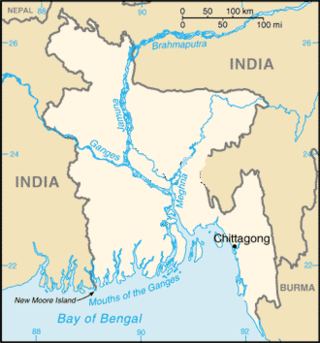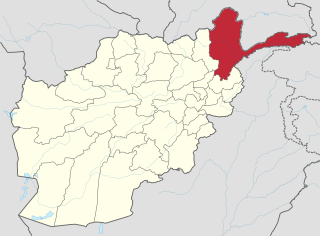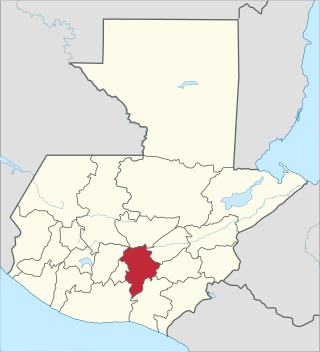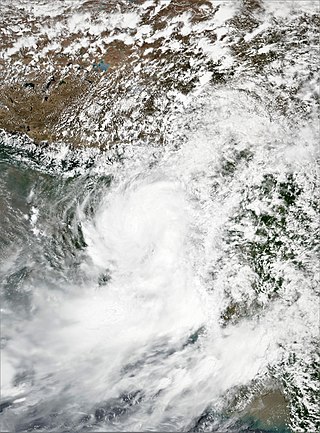
On February 17, 2006, a massive rock slide-debris avalanche occurred in the Philippine province of Southern Leyte, causing widespread damage and loss of life. The deadly landslide followed a 10-day period of heavy rain and a minor earthquake. The official death toll was 1,126.

Argo District is one of the 28 districts in Badakhshan province, Afghanistan. It was created in 2005 from part of Fayzabad District and is home to approximately 45,000 residents.

The 2007 Chittagong mudslides occurred in the port city of Chittagong in south-eastern Bangladesh. On 11 June 2007, heavy monsoon rainfall caused mudslides that engulfed slums around the hilly areas of the city. Experts had previously warned the increasing likelihood of landslides due to the Bangladesh government's failure in curbing the illegal hill cutting taking place in Chittagong.
The 2008 Shanxi mudslide was caused by the collapse of an unlicensed mine landfill in Xiangfen county, Linfen, Shanxi Province, People's Republic of China which caused 277 dead, 4 missing and 33 injured. Around 8:00 a.m. on September 8, 2008, the retaining wall of a waste iron ore reservoir collapsed after torrential rain, causing a major mudslide which inundated a village and crowded marketplace. The unlicensed Tashan Mine was operated by the Tashan Mining Company.

The 2009 Messina floods and mudslides occurred in Sicily on the night of 1–2 October, mainly along the Ionian coast in the Province of Messina. They also affected other parts of northeastern Sicily and killed a total of at least 31 people, some of whom were swept out to sea. More than 400 people were left homeless, as many houses collapsed.

The 2010 Ugandan landslide occurred in the Bududa District in eastern Uganda on 1 March 2010. The landslide was triggered by heavy rain between 12 pm and 7 pm that day. At least 100 people were believed to have been killed, and 94 bodies were found.

The 2010 China floods began in early May 2010. Three hundred and ninety-two people died, and a further 232 people were reported missing as of June 30, 2010, including 57 people in a landslide in Guizhou. Fifty-three of the deaths occurred from the flooding and landslides between May 31 and June 3, and 266 deaths occurred between June 13 and June 29. Four hundred and twenty four people were killed by the end of June, including 42 from the Guizhou landslide; 277 more were killed and 147 were missing in the first two weeks of July, bringing the death toll as of August 5 to 1,072. A landslide in early August in Gansu killed at least 1,471 people and left 294 missing. In total, the flooding and landslides killed at least 3,185 people in China by August 31. More than 230 million people in 28 provinces, municipalities, and regions, especially the southern and central provinces and regions of Zhejiang, Fujian, Jiangxi, Hubei, Hunan, Guangdong, Guangxi, Chongqing Municipality, Gansu, Sichuan, and Guizhou, and the northeastern province of Jilin were affected, while at least 4.66 million people were evacuated because of the risk of flooding and landslides in the latter half of June. By early August, over 12 million people were evacuated, and that number rose to 15.2 million by August 31.
The 2010 Gansu mudslide was a deadly mudslide in Zhouqu County, Gansu Province, Gannan Tibetan Autonomous Prefecture, China that occurred at midnight on 8 August 2010. The floods were triggered after decades of clear cut logging practices had reduced the ability of the watershed to absorb heavy rainfall.

On 30 July 2014, a landslide occurred in the village of Malin in the Ambegaon taluka of the Pune district in Maharashtra, India. The landslide, which hit early in the morning while residents were asleep, was believed to have been caused by a burst of heavy rainfall, and killed at least 151 people. Rains continued after the landslide making rescue efforts difficult.

At 7:30 am on 29 October 2014, a landslide struck the Sri Lanka district of Badulla, killing at least 16 people and leaving an estimated 200 missing. The landslide was triggered by monsoon rains, and occurred at about 7:30 AM local time.

On 13 December 2014, a landslide in Banjarnegara, Central Java, Indonesia, killing 93 with 23 people missing. The disaster occurred on Jemblung Village in Banjarnegara, Indonesia, at Friday, around 03.00 p.m. At the time, most of the villagers were taking a nap on their houses. The landslides also trapped some vehicles on the road. Amateur video caught the moment when a large piece of the mountain fell to the whole village. Indonesian authority said that at least around 100 people are feared dead and 300 houses were destroyed.

On 23 April 2015, a landslide occurred in the Khawahan district of Badakhshan Province in Afghanistan. Around 100 houses were destroyed and 52 people were killed by the landslide. A second landslide occurred on 26 April, displacing 120 families.

On October 1, 2015, heavy rains triggered a major landslide in the village of El Cambray Dos within Santa Catarina Pinula, Guatemala—15 km (9.3 mi) east of Guatemala City, killing at least 280 people and leaving dozens unaccounted for across the village. The landslide leveled much of the village, leaving some areas under 15 m (49 ft) of earth and debris.

On 12 June 2017, heavy monsoon rain triggered a series of landslides and floods in Rangamati, Chittagong and Bandarban - three hilly districts of Bangladesh - and killed at least 152 people. The weather also caused power cuts and telecommunications disruptions, making it difficult for rescuers to reach affected communities. Reaz Ahmed, head of Bangladesh's Disaster Management Department, said the landslides were the worst in the country's history.

On the morning of August 14, 2017, significant mudflow events occurred in and around the capital city of Freetown in Sierra Leone. Following three days of torrential rainfall, mass wasting of mud and debris damaged or destroyed hundreds of buildings in the city, killing 1,141 people and leaving more than 3,000 homeless.
On 22 April 2019, a landslide triggered the collapse of a jade mine near Maw Wun Kalay, Hpakant, Kachin State, Myanmar, trapping at least 54 miners. The deaths of four miners were confirmed, along with the later deaths of two rescue workers. The remaining miners are presumed to be dead.
On December 22, 2021, a landslide occurred at a jade mine in the township of Hpakant in Kachin State, Myanmar. The landslide killed at least three people, and left at least 70 to 100 missing.
A large landslide occurred in Noney district of the Indian state of Manipur near the Tupul railway construction site on the night of 30 June 2022. It killed 58 people and three people were missing. Eighteen people were injured. Twenty-nine Indian Army personnel and 29 civilians were among the deceased. Of the missing three people, two were civilians and one was an Indian Army personnel.
In Maco, Davao de Oro, Philippines, a landslide occurred after heavy rainfall on February 6, 2024, killing at least 98 people.













